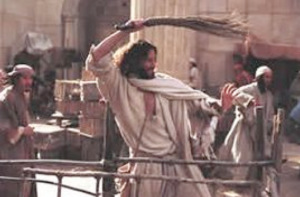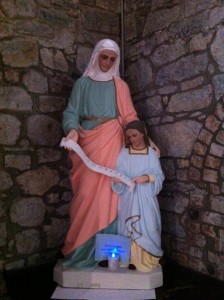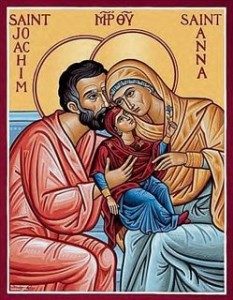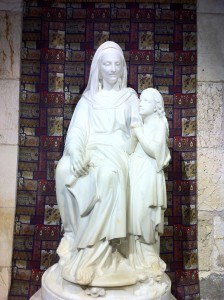Take a pilgrimage with Steve and Janet Ray!
Was Jesus Nice?
I wish I had a dollar for every time someone has said to me. “That was not very Christ-like.” This response usually comes after being honest to the point of making someone upset. The implication is that Jesus was a cuddly little nice guy who was always smiling, always accepting with kind words – in short NICE.
In America we tend to be pretty nice, except maybe if you live in New York City. But in contrast to the rest of the world we tend to be very polite, genteel, gracious and nice. Tour guides in other countries say that Americans are the nicest people. We transpose our niceness onto Jesus and think he was a lot like us.
But does LOVE = NICE?
Of course Jesus was loving. He is God after all and God is love (1 John 4:8). We also know that love does not always equate to NICE. God allowed Paul to have a thorn in the flesh to keep him humble (2 Cor 12:7). Three times Paul prayed for it to be removed. God said NO. God was not acting very American. He certainly wasn’t very nice about it.
Nice is defined primarily as “pleasant or commendable, kind or friendly” (Collins English Dictionary). It originally comes from the Latin meaning “simple, silly or ignorant.”
There is such a thing as “tough love.” It is the kind of love that cares enough to be honest, to confront, to discipline, to cause temporary pain to bring about eternal glory. On the surface “tough love” does not always appear to be nice. How often has a child, sent to the corner blurt out “You are not very nice!”
Was Jesus nice?
Like Aslan the Lion in C. S. Lewis’ Narnia series, Jesus is approachable and loving, but don’t ever consider him “tame” or too cuddly. Jesus is God as well as man. He expressed the wrath and anger of God as well as the mercy and love of God.
Imagine coming to the Temple in Jerusalem one day to pray. You hear a great commotion and run over to see an angry man throwing over tables, grabbing the money from the merchants and throwing the money on the ground.
But worse, you see him make a scourge of cords – a whip – and striking people with it. You are shocked that anyone would be so rude and destructive, so inconsiderate and mean to lash people with a whip. People ran in fear! Everyone was upset. Jesus was red in the face and scowling. It certainly wasn’t very “Christ-like.” How nice was that?
Jesus was always loving, but he was not always nice, as we Americans count niceness. Here is just one example. Jesus spoke very harshly to his fellow Jews.
“Woe to you, scribes and Pharisees, hypocrites! for you are like whitewashed tombs, which outwardly appear beautiful, but within they are full of dead men’s bones and all uncleanness. So you also outwardly appear righteous to men, but within you are full of hypocrisy and iniquity. . . . You serpents, you brood of vipers, how are you to escape being sentenced to hell? (Matthew 23:27, 28, 33).
Ouch! It doesn’t sound very kind and courteous: not very thoughtful or nice!
So, maybe there is more to WWJD (What Would Jesus Do?) than we’ve been led to believe. Maybe we shouldn’t worry so much about being nice, being liked, acting like genteel Americans. Maybe we ought to be more honest and forthright about the things that really matter. Maybe we should be more willing to hurt some feelings, step on some toes, show tough love to those in sin.
Maybe we should be more Christ-like.
Joachim & Anna: Nativity and Presentation of the Blessed Virgin Mary
November 21 is the Feast of the Presentation of Mary in the Temple in 2023. Joachim and Anna’s story, along with the story of Mary’s presentation is not told in the Bible, but in a 2nd-century document entitled The Protoevangelium of James. In this document we read of the birth and presentation of Mary and her childhood through her marriage to Joseph and the birth of Jesus. This document was known and loved by the first Christians. It is the source for the names of Mary’s parents Joachim and Anna. It is fascinating.
I have only provided the first 1/3 of the document. The second part is about Joseph and Mary’s betrothal. The third about the birth of Jesus.
The Protoevangelium of James
The Birth of Mary the Holy Mother of God,
and Very Glorious Mother of Jesus Christ
IN THE RECORDS OF THE TWELVE TRIBES OF ISRAEL was Joachim, a man rich exceedingly; and he brought his offerings double, saying: There shall be of my superabundance to all the people, and there shall be the offering for my forgiveness to the Lord for a propitiation for me. For the great day of the Lord was at hand, and the sons of Israel were bringing their offerings. And there stood over against him Rubim, saying: It is not meet for thee first to bring thine offerings, because thou hast not made seed in Israel. And Joachim was exceedingly grieved, and went away to the registers of the twelve tribes of the people, saying: I shall see the registers of the twelve tribes of Israel, as to whether I alone have not made seed in Israel. And he searched, and found that all the righteous had raised up seed in Israel. And he called to mind the patriach Abraham, that in the last day God gave him a son Isaac. And Joachim was exceedingly grieved, and did not come into the presence of his wife; but he retired to the desert, and there pitched his tent, and fasted forty days and forty nights, saying in himself: I will not go down either for food or for drink until the Lord my God shall look upon me, and prayer shall be my food and drink.
 2. And his wife Anna mourned in two mournings, and lamented in two lamentations, saying: I shall bewail my widowhood; I shall bewail my childlessness. And the great day of the Lord was at hand; and Judith her maid-servant said: How long dost thou humiliate thy soul? Behold, the great day of the Lord is at hand, and it is unlawful for thee to mourn. But take this head-band, which the woman that made it gave to me; for it is not proper that I should wear it, because I am a maid-servant, and it has a royal appearance. And Anna said: Depart from me; for I have not done such things, and the Lord has brought me very low. I fear that some wicked person has given it to thee, and thou hast come to make me a sharer in thy sin. And Judith said: Why should I curse thee, seeing that the Lord hath shut thy womb, so as not to give thee fruit in Israel? And Anna was grieved exceedingly, and put off her garments of mourning, and cleaned her head, and put on her wedding garments, and about the ninth hour went down to the garden to walk. And she saw a laurel, and sat under it, and prayed to the Lord, saying: O God of our fathers, bless me and hear my prayer, as Thou didst bless the womb of Sarah, and didst give her a son Isaac.
2. And his wife Anna mourned in two mournings, and lamented in two lamentations, saying: I shall bewail my widowhood; I shall bewail my childlessness. And the great day of the Lord was at hand; and Judith her maid-servant said: How long dost thou humiliate thy soul? Behold, the great day of the Lord is at hand, and it is unlawful for thee to mourn. But take this head-band, which the woman that made it gave to me; for it is not proper that I should wear it, because I am a maid-servant, and it has a royal appearance. And Anna said: Depart from me; for I have not done such things, and the Lord has brought me very low. I fear that some wicked person has given it to thee, and thou hast come to make me a sharer in thy sin. And Judith said: Why should I curse thee, seeing that the Lord hath shut thy womb, so as not to give thee fruit in Israel? And Anna was grieved exceedingly, and put off her garments of mourning, and cleaned her head, and put on her wedding garments, and about the ninth hour went down to the garden to walk. And she saw a laurel, and sat under it, and prayed to the Lord, saying: O God of our fathers, bless me and hear my prayer, as Thou didst bless the womb of Sarah, and didst give her a son Isaac.
3. And gazing towards the heaven, she saw a sparrow’s nest in the laurel, and made a lamentation in herself, saying: Alas! who begot me? and what womb produced me? because I have become a curse in the presence of the sons of Israel, and I have been reproached, and they have driven me in derision out of the temple of the Lord. Alas! to what have I been likened? I am not like the fowls of the heaven, because even the fowls of the heaven are productive before Thee, O Lord. Alas! to what have I been likened? I am not like the beasts of the earth, because even the beasts of the earth are productive before Thee, O Lord. Alas! to what have I been likened? I am not like these waters, because even these waters are productive before Thee, O Lord. Alas! to what have I been likened? I am not like this earth, because even the earth bringeth forth its fruits in season, and blesseth Thee, O Lord.

4. And, behold, an angel of the Lord stood by, saying: Anna, Anna, the Lord hath heard thy prayer, and thou shalt conceive, and shall bring forth; and thy seed shall be spoken of in all the world. And Anna said: As the Lord my God liveth, if I beget either male or female, I will bring it as a gift to the Lord my God; and it shall minister to Him in holy things all the days of its life. And, behold, two angels came, saying to her: Behold, Joachim thy husband is coming with his flocks. For an angel of the Lord went down to him, saying: Joachim, Joachim, the Lord God hath heard thy prayer Go down hence; for, behold, thy wife Anna shall conceive. And Joachim went down and called his shepherds, saying: Bring me hither ten she-lambs without spot or blemish, and they shall be for the Lord my God; and bring me twelve tender calves, and they shall be for the priests and the elders; and a hundred goats for all the people. And, behold, Joachim came with his flocks; and Anna stood by the gate, and saw Joachim coming, and she ran anti hung upon his neck, saying: Now I know that the Lord God hath blessed me exceedingly; for, behold the widow no longer a widow, and I the childless shall conceive. And Joachim rested the first day in his house.
 5. And on the following day he brought his offerings, saying in himself: If the Lord God has been rendered gracious to me, the plate on the priest’s forehead will make it manifest to me. And Joachim brought his offerings, and observed attentively the priest’s plate when he went up to the altar of the Lord, and he saw no sin in himself. And Joachim said: Now I know that the Lord has been gracious unto me, and has remitted all my sins. And he went down from the temple of the Lord justified, and departed to his own house. And her months were fulfilled, and in the ninth month Anna brought forth. And she said to the midwife: What have I brought forth? and she said: A girl. And said Anna: My soul has been magnified this day. And she laid her down. And the days having been fulfilled, Anna was purified, and gave the breast to the child, and called her name Mary.
5. And on the following day he brought his offerings, saying in himself: If the Lord God has been rendered gracious to me, the plate on the priest’s forehead will make it manifest to me. And Joachim brought his offerings, and observed attentively the priest’s plate when he went up to the altar of the Lord, and he saw no sin in himself. And Joachim said: Now I know that the Lord has been gracious unto me, and has remitted all my sins. And he went down from the temple of the Lord justified, and departed to his own house. And her months were fulfilled, and in the ninth month Anna brought forth. And she said to the midwife: What have I brought forth? and she said: A girl. And said Anna: My soul has been magnified this day. And she laid her down. And the days having been fulfilled, Anna was purified, and gave the breast to the child, and called her name Mary.
7. And her months were added to the child. And the child was two years old, and Joachim said: Let us take her up to the temple of the Lord, that we may pay the vow that we have vowed, lest perchance the Lord send to us, and our offering be not received. And Anna said: Let us wait for the third year, in order that the child may not seek for father or mother. And Joachim said: So let us wait. And the child was three years old, and Joachim said: Invite the daughters of the Hebrews that are undefiled, and let them take each a lamp, and let them stand with the lamps burning, that the child may not turn back, and her heart be captivated from the temple of the Lord. And they did so until they went up into the temple of the Lord. And the priest received her, and kissed her, and blessed her, saying: The Lord has magnified thy name in all generations. In thee, on the last of the days, the Lord will manifest His redemption to the sons of Israel. And he set her down upon the third step of the altar, and the Lord God sent grace upon her; and she danced with her feet, and all the house of Israel loved her.
 8. And her parents went down marveling, and praising the Lord God, because the child had not turned back. And Mary was in the temple of the Lord as if she were a dove that dwelt there, and she received food from the hand of an angel. And when she was twelve years old there was held a council of the priests, saying: Behold, Mary has reached the age of twelve years in the temple of the Lord. What then shall we do with her, test perchance she defile the sanctuary of the Lord? And they said to the high priest: Thou standest by the altar of the Lord; go in, and pray concerning her; and whatever the Lord shall manifest unto thee, that also will we do. And the high priest went in, taking the robe with the twelve bells into the holy of holies; and he prayed concerning her. And behold an angel of the Lord stood by him, saying unto him: Zacharias, Zacharias, go out and assemble the widowers of the people, and let them bring each his rod; and to whomsoever the Lord shall show a sign, his wife shall she be. And the heralds went out through all the circuit of Judaea, and the trumpet of the Lord sounded, and all ran.
8. And her parents went down marveling, and praising the Lord God, because the child had not turned back. And Mary was in the temple of the Lord as if she were a dove that dwelt there, and she received food from the hand of an angel. And when she was twelve years old there was held a council of the priests, saying: Behold, Mary has reached the age of twelve years in the temple of the Lord. What then shall we do with her, test perchance she defile the sanctuary of the Lord? And they said to the high priest: Thou standest by the altar of the Lord; go in, and pray concerning her; and whatever the Lord shall manifest unto thee, that also will we do. And the high priest went in, taking the robe with the twelve bells into the holy of holies; and he prayed concerning her. And behold an angel of the Lord stood by him, saying unto him: Zacharias, Zacharias, go out and assemble the widowers of the people, and let them bring each his rod; and to whomsoever the Lord shall show a sign, his wife shall she be. And the heralds went out through all the circuit of Judaea, and the trumpet of the Lord sounded, and all ran.
Click here for the rest of the document
Older Posts
Wisconsin Pilgrimage Last Day – Farewells & Departures
It’s been a marvelous pilgrimage together and today is our last day. Cardinal Burke was the highlight of the trip for most of the pilgrims—like
Wisconsin Pilgrimage Day 3
Rudolph Grotto Gardens is a spectacular property with caves, tunnels, walkways and gardens all designed with biblical and Catholic themes. Free time to wander and
Wisconsin Pilgrimage Day 2
The Hyatt Regency hotel is beautiful and everyone really enjoyed it. After our private breakfast, we boarded our good air-condition bus with our driver, Mike
Wisconsin Shrine Pilgrimage Day 1
These videos are mostly made for our current Pilgrims and their family and friends watching them back home. But everyone is more than welcome to
An Insightful Article on the Life & Times of Joe Biden and what the future holds
Joe Biden and a Tear in the Fabric of Things Last month’s debate destroyed the carefully crafted myth of Biden as an empathetic, intelligent and
Saints & Shrines of France – including D-Day and Opening of Notre Dame Cathedral!
The first time we did this pilgrimage through France it was a huge success and a very blessed time. This trip will be even better!
“The 12 Unknown Sorrows of Mary” – Steve Ray’s Biblical Meditations
We have the Devotion of the “Seven Dolores”, or the Devotion of the Seven Sorrows. But Mary suffered far more sorrows than those seven. From ‘The
Vance not the choice of some Catholics?
It is sad that so many expect perfection before they will stand behind a good man. We have two choices this November — radically different
JD Vance, Catholic Convert, Trump’s New Running Mate
Trump has chosen his vice president and it will be JD Vance. He’s a young senator from Ohio and a recent convert to the Catholic
“The Bible in 10 Minutes” – if you haven’t watched this yet, it is quite good
Q & A from Non-Catholics – Questions I answered on Catholic Answers Live
It is always a great joy to answer lots of questions from non-Catholics who are questioning Catholic teaching and practice. Some of them are belligerent
Apostolic Fathers, Part II with William Albrecht: Polycarp, Clement, Justin Martyr & Ireneaus
A month ago William Albrecht and I got together for an hour to discuss the Apostolic Fathers in general and then honed in on the


















Upcoming Events
Very true!
And they say we are trying to subvert democracy!
Random Quote
Infant Baptism the Church has always had, always held; this she received from the faith of our ancestors; this she perseveringly guards even to the end.
Blog Calendar
Blog Categories
- Apologetics (543)
- Art, Music & Science (83)
- Artifacts & Biblical History (222)
- Atheism (27)
- Bible Study (173)
- Biblical Exposition (378)
- Books (77)
- Canon Law (143)
- Catholic Answers Live (162)
- Catholic Controversies (91)
- Catholic Issues (345)
- Church History (97)
- Computers-Software (51)
- Conferences (279)
- Conversions (281)
- Cultural Chaos (38)
- Current Affairs (203)
- Death & Dying (9)
- Eastern Churches (5)
- Economy (6)
- Education (73)
- Evangelization (29)
- Family and Kids (320)
- Footprints of God DVD's (180)
- Friends (59)
- Fun Stuff (476)
- Health/Running (187)
- Heresy, Cults (12)
- Heroic Models (14)
- Holidays/Feast Days (248)
- Homosexuality (43)
- Inheritance Pilgrimages (13)
- Islam (193)
- Israel and Middle East (221)
- Jesus/Godhead (81)
- Jews & Judaism (43)
- Liturgy & Priesthood (174)
- Mary (128)
- Miscellaneous (92)
- Moral/Sexual Issues (296)
- Movies, TV & Media (121)
- Nature & Birds (27)
- News, In the (134)
- Papacy & Catholic Hierarchy (205)
- Patristics/Church History (36)
- Persecution, Suffering (36)
- Philippines (45)
- Philosophy (15)
- Photographs (8)
- Pilgrimage (778)
- Pilgrimages (1,635)
- Pilgrimages Inheritance (1)
- Politics/United States (752)
- Pope Benedict (86)
- Pope Francis (158)
- Prayer & Spiritual Life (216)
- ProLife & Family Issues (496)
- Protestant/Other Christians (150)
- Radio & TV Shows, Steve's (264)
- Radio & TV, others (20)
- Religions, Non-Christian (48)
- Reviews, Critiques, Surveys (161)
- Riddles and Fun (175)
- Sacraments & Sacramentals (151)
- Saints and Fathers (201)
- Social Issues & Action (204)
- Sports & Celebrities (10)
- Steve's Talks & Real Audio (139)
- Steve's Writings (96)
- Teaching & Suggestions (98)
- Theology (113)
- Travel (324)
- Uncategorized (403)
- Video Clips (129)
- Virus (6)
- Virus and Health (11)
- Website, mine (66)
- Website, others (44)
















